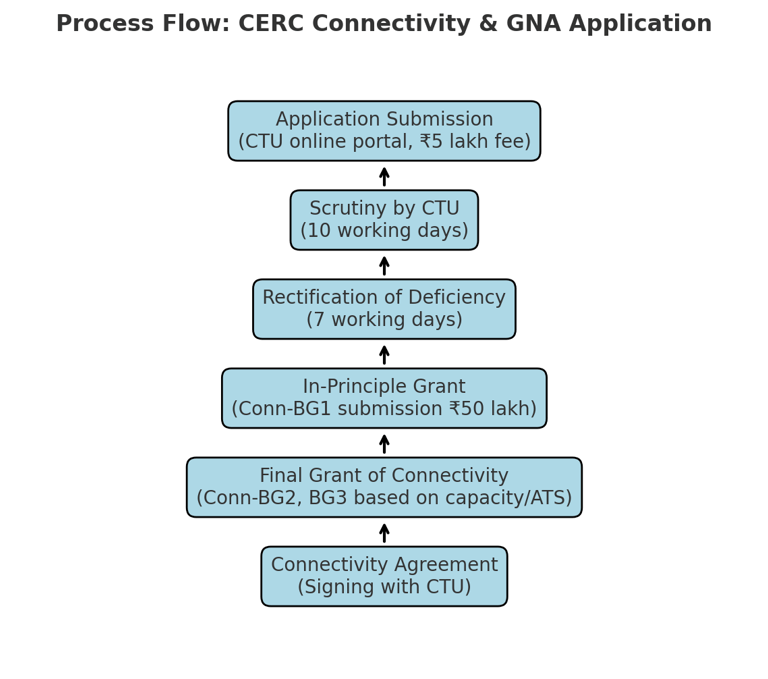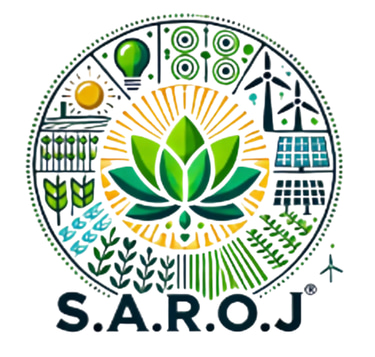CERC (Connectivity and General Network Access to the inter-State Transmission System) (Third Amendment) Regulations, 2025
CERC GNA Regulations with all amendments
9/7/20255 min read


CERC’s Connectivity & General Network Access (GNA) Regulations with 3rd Amendment
The CERC (Connectivity and General Network Access to the Inter-State Transmission System) Regulations, 2022, notified on June 7, 2022, and consolidated with its First, Second, and Third Amendments (the latest on August 31, 2025), represent a transformative overhaul of India's inter-state transmission access framework. By replacing the outdated 2009 Connectivity Regulations, it introduces General Network Access (GNA) as a perpetual, non-discriminatory right to use the ISTS, fostering seamless integration for renewables, storage, and conventional power. This is pivotal for achieving India's 500 GW non-fossil fuel target by 2030, emphasizing digital processes via the National Open Access Registry (NOAR), stringent financial safeguards like bank guarantees (BGs), and innovations for solar and hybrid projects. With provisions for Temporary GNA (T-GNA) and renewable-specific access, the regulations balance grid stability, market efficiency, and developer incentives in a sector facing rapid electrification demands.
1. Eligibility for Connectivity and GNA
Eligibility is broad yet threshold-based to ensure grid viability and prevent speculative bids. Key entities include generating companies, transmission/distribution licensees, consumers, and intra-state entities (with SLDC metering). Specifics for connectivity (physical linkage to ISTS) under Regulation 4:
1. Generating Stations (including REGS and RHGS with/without ESS): Minimum quantum ≥ 10 MW (injected capacity).
* Relaxation: ≥ 5 MW if via a "Lead Generator" already connected or for clustered projects under Renewable Power Park Developers (RPPD).
* North Eastern Region/Sikkim: ≥ 5 MW for RE/ESS linked to BBMB or shared bays.
2. Captive Generating Plants or Standalone ESS: ≥ 50 MW drawal/injection capacity.
3. Intra-State Entities/Loads: ≥ 50 MW, with mandatory "Standing Clearance" from SLDC (Regulation 31).
4. Renewable Energy Implementing Agencies (REIAs): Designated by Central/State Governments for procuring/reselling RE power, ≥ 50 MW aggregate.
5. Clusters/Hybrids: REGS/ESS ≥ 5 MW via Lead ESS/Generator agreements for single-point connectivity (Regulation 2.1(x),(y)).
6. Deemed Eligibility: Existing Long-Term Access (LTA) holders auto-transition to GNA (Regulation 17.1).
👉 Additions like the Third Amendment expand access for sub-10 MW distributed solar/rooftop via RPPDs, promoting aggregation and ESS co-location to mitigate intermittency.
For GNA (open access rights), similar thresholds apply (Regulation 17), with GNA-RE for exclusive renewable drawal (under Sharing Regulations clause 2).
2. Application Process & Forms
The process is fully digital and timestamped for transparency, managed by Nodal Agency (CTU for connectivity/GNA; RLDC/NLDC for T-GNA). Under Regulation 3:
* Mode: Online via CTU/NOAR portal; applications batched monthly by 2400 hrs last day for joint processing (inter-se priority by timestamp).
* Authentication: Digital signature by authorized signatory; auto-acknowledgement with date-time stamp displayed on Nodal Agency website.
* Timeline: Scrutiny within 10 working days; rectify deficiencies in 7 days (no timestamp change; minor ones listed on CTU site won't reject).
* In-Principle Grant: 45-60 days post-scrutiny, assessing ATS (Associated Transmission System) per Regulation 6 (CEA standards).
* Final Grant: Within 15 days of BG submission and clearances; sign Connectivity Agreement (Cat-1, Regulation 10).
Key Documents (Regulation 5.8):
* Form with quantum, interconnection point (ISTS substation/cluster), and scheduling details.
* Affidavit, board resolution, and promoter/shareholding pattern (to curb speculation).
* Land documents/LOA (for ≥100 MW; release on partial withdrawal).
* PPA/implementation agreement for REIAs/RPPDs.
* BG details and CEA compliance certificate.
* For intra-state: SLDC Standing Clearance.
Addition: Third Amendment mandates max injection/drawal specs for ESS-equipped REGS and RLDC publication of bay utilization data for real-time monitoring.
3. Application Fees
Affordable and uniform to encourage participation (Regulations 3.2-3.3):
* ₹5,00,000 per application + GST (non-refundable base).
* Exempt: State Transmission Utilities (STUs) for GNA applications.
* Forfeiture on Closure: 20% if deficiencies not rectified; balance refunded in 15 days.
* Transmission Charges: Post-grant, uniform per Sharing Regulations, 2020 (no upfront for GNA, but usage-based).
Addition: No fee for T-GNA extensions, but RLDC Fees Regulations apply for short-term processing.
4. Processing & Withdrawal
Efficient scrutiny ensures fairness (Regulation 3.5-3.6):
* CTU Scrutiny: 10 working days; lists minor vs. major deficiencies (major = rejection).
* Rectification: 7 days; non-compliance closes application.
* Batch Processing: All monthly apps together; priority by timestamp.
* ATS Determination: System impact study for upgrades (Regulation 6).
Withdrawal Rules (Regulation 3.7):
* Pre-In-Principle: 50% fee forfeited; 50% + proportionate BG refunded in 15 days.
* Post-In-Principle, Pre-Final: 100% fee + 5% BG forfeited; balance BG refunded (Conn-BG1 encashed if furnished; Conn-BG2 if ATS awarded).
* Post-Final, Pre-Agreement: 100% fee + 15% BG forfeited; balance refunded.
* Partial Quantum Withdrawal: Allowed if balance ≥ minima; proportionate BG/land docs released in 15 days (Third Amendment softens penalties for RE capacity constraints).
Addition: Applications deemed withdrawn if no response in 6 months; NOAR tracks status for appeals.
5. Bank Guarantee (BG) Structure
BGs enforce commitment and fund infrastructure (Regulation 5.8; up to 1.5x ATS cost):
* Conn-BG1: ₹50 lakh (general security; encashable on delays).
* Conn-BG2: For terminal bays (₹1-12 crore/bay by voltage) + ATS augmentation (30-50% estimated cost; encashable if works awarded).
* Conn-BG3: ₹2 lakh/MW for ISTS strengthening/ESS integration.
* Refund Milestones: Post-land acquisition (BG1), bay commissioning (BG2), or full operationalization.
* For GNA: Similar but scaled to drawal quantum; T-GNA requires nominal RLDC BG.
Addition: Third Amendment reduces forfeiture for partial RE withdrawals (e.g., 5% vs. 15%) and allows source changes (solar to wind) post-approval with CTU nod, easing hybrid pivots.
6. Types of Access
Diverse options for flexibility (Chapter 4-6):
1. GNA (General Network Access): Perpetual open access to ISTS; scheduling via NOAR (Regulation 22).
2. GNA-RE: Renewable-exclusive GNA for drawal from specified sources (e.g., solar/wind under Sharing Reg 13(2)).
3. T-GNA (Temporary GNA): Up to 3 months for bilateral (via RLDC) or collective trades (NLDC); extendable.
4. T-GNA-RE: Renewable-specific short-term.
5. Solar/Non-Solar Hour Access (Third Amendment Addition):
* Solar Hour Access: Injection rights during NLDC-declared solar blocks (weekly, Friday-declared based on insolation); drawal anytime, limited to connectivity quantum (Annexure-IV).
* Non-Solar Hour Access: For wind/ESS; full-day drawal with non-solar injection.
* Hybrids/ESS: Mixed, with max limits specified.
Addition: Cross-border access links to 2019 Regulations; ESS as "Lead" for clusters enables shared bays.
7. Monitoring & Compliance
Robust oversight for grid discipline (Regulations 27, 37):
* Quarterly Reporting: Developers submit progress (land, BGs, commissioning) to CTU; publish benchmarks for land/MW costs.
* NOAR Integration: NLDC-managed registry for real-time scheduling, metering (Interface Meters per CEA 2006), and energy accounting.
* Compliance Checks: RLDC/SLDC monitor deviations (DSM Regulations linkage); publish bay utilization quarterly.
* Penalties: Revocation + full BG encashment for non-compliance/delays >6 months; Standing Clearance revocation for intra-state defaulters.
* Audits: CTU verifies affidavits/promoter details; speculative apps flagged via shareholding disclosures.
Addition: Third Amendment mandates weather-based intra-week solar hour adjustments and cluster reallocation of vacant bays to optimize ISTS usage.
8. Third Amendment – Key Updates
Notified on August 31, 2025, the Third Amendment enhances renewable agility and grid efficiency amid surging solar deployments. It introduces "Cluster of ISTS Substations"—grouping by CTU based on geography, feasibility, and planning (e.g., planned/under-construction sites)—for shared bays and reallocation of underutilized infrastructure, curbing duplication. NLDC now declares "solar hours" (insolation-based time blocks) weekly on Fridays for Monday-Sunday, with provisions for anomalies, enabling "solar hour access" (peak injection rights + full-day drawal) and "non-solar hour access" for differentiated RE/ESS scheduling (Regulation 5.11, Annexure-IV). Eligibility widens for <10 MW via RPPDs/Lead entities; relaxes financial closure/land norms; allows post-approval renewable source switches. BG/withdrawal rules ease (lower forfeitures for partials), and RLDCs must publish utilization data. Transition: Pending apps realign within 1 month; in-principle grantees furnish updated BGs/promoter details in 2 weeks. These curb speculation while boosting 500 GW RE integration.
9. Why This Matters
The GNA regulations are a strategic enabler for India's energy transition:
* Streamline Access: Replaces rigid LTA/MTOA with flexible GNA, cutting approval times by 50%.
* Renewable Boost: Solar/non-solar provisions + ESS clustering address variability; GNA-RE exempts from certain losses.
* Financial Safeguards: BGs/affidavits ensure only viable projects; NOAR digitizes for transparency.
* Grid Resilience: Links to Grid Code/DSM for stability; clusters optimize ₹2.5 lakh crore ISTS investments.
* Stakeholder Wins: Developers get predictable scheduling; DISCOMs/cheaper OA; intra-state entities cross-border ease.
Addition: In 2025's context, with RE additions at 20 GW/year, these rules mitigate curtailments (down 30% YoY) and support net-zero via ESS mandates.
✅ In essence, CERC's GNA framework is the architect of a unified, green grid—driving accountability, innovation, and inclusivity for a sustainable power future. Developers: Bookmark CTU/NOAR portals; consult for cluster apps. For queries, refer to CERC's consolidated PDF or latest notifications.


